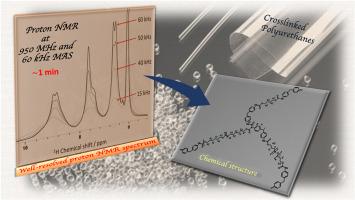Unravelling crosslinking and molecular structure in complex polyurethanes via advanced multinuclear solid-state NMR
IF 4.1
2区 化学
Q2 POLYMER SCIENCE
引用次数: 0
Abstract
A crucial aspect of creating cutting-edge chemical processes that enhance mechanical strength, stability, sustainability, and circularity is acquiring a more profound comprehension of the atomic-scale structure of native polymers. In this work, we present a multinuclear 13C and 15N solid-state NMR combined with fast magic angle spinning (fast-MAS) 1H NMR at high magnetic field (22.3 T) in characterizing thermoplastic polyurethanes (PUs) chemistry. The study highlights the significance of performing atomic-scale characterization to obtain an accurate chemical picture of the polymers, especially when investigating crosslinking among polymer chains. This is because indirect confirmation of crosslinking, such as through molecular weight gains or losses, can only provide an incomplete picture, due to the complex chemical structure involved. Moreover, given that variations in synthesis parameters, such as the ratio of reactants, can significantly influence the properties of polyurethanes, it is essential to establish structure-function relationships in these polymers.
This research notably emphasizes the significance of fast-MAS 1D 1H NMR at high-field in characterizing multiple polyurethane samples within a brief experimental duration of minutes. The study demonstrates that fast-MAS 1H NMR facilitates straightforward chemical shift assignment and enables quantitative comparison of chemical compositions among three complex PU samples synthesized with distinct reactant proportions. Finally, this study examines the limitations of 1H fast-MAS NMR, particularly in the context of characterizing low levels of crosslinking in polyurethanes. Despite the inherent low sensitivity of 15N nuclei, this research demonstrates that 15N Cross-Polarization (CPMAS) NMR experiment serves as robust method for the unambiguous detection of allophanates in polyurethanes.


求助全文
约1分钟内获得全文
求助全文
来源期刊

Polymer
化学-高分子科学
CiteScore
7.90
自引率
8.70%
发文量
959
审稿时长
32 days
期刊介绍:
Polymer is an interdisciplinary journal dedicated to publishing innovative and significant advances in Polymer Physics, Chemistry and Technology. We welcome submissions on polymer hybrids, nanocomposites, characterisation and self-assembly. Polymer also publishes work on the technological application of polymers in energy and optoelectronics.
The main scope is covered but not limited to the following core areas:
Polymer Materials
Nanocomposites and hybrid nanomaterials
Polymer blends, films, fibres, networks and porous materials
Physical Characterization
Characterisation, modelling and simulation* of molecular and materials properties in bulk, solution, and thin films
Polymer Engineering
Advanced multiscale processing methods
Polymer Synthesis, Modification and Self-assembly
Including designer polymer architectures, mechanisms and kinetics, and supramolecular polymerization
Technological Applications
Polymers for energy generation and storage
Polymer membranes for separation technology
Polymers for opto- and microelectronics.
 求助内容:
求助内容: 应助结果提醒方式:
应助结果提醒方式:


